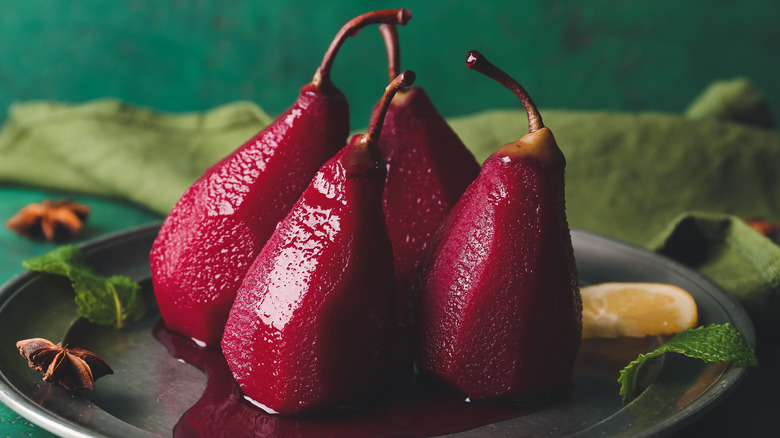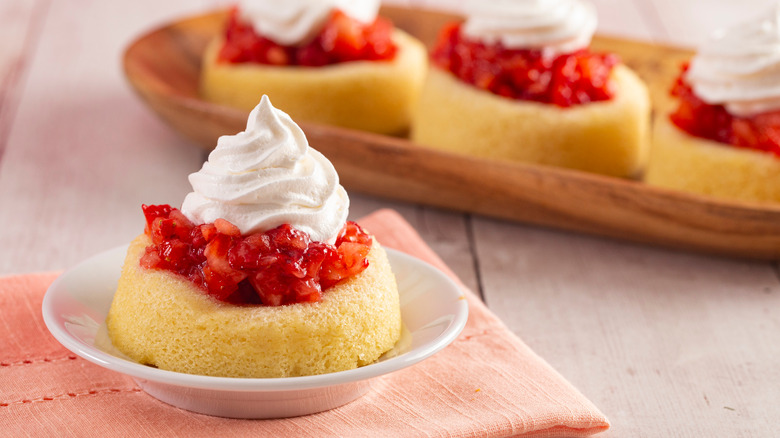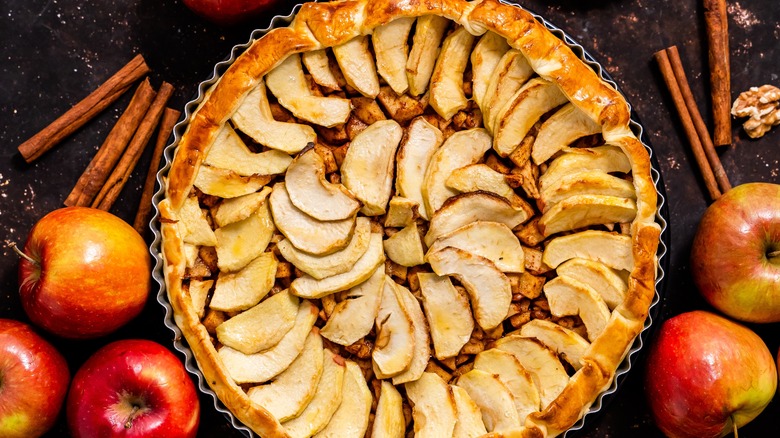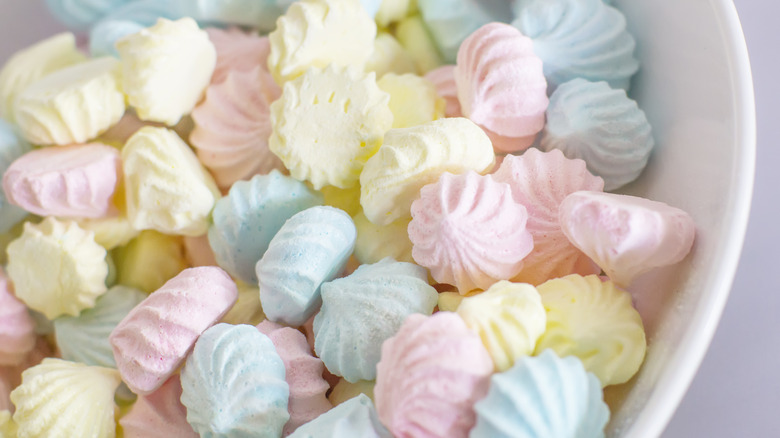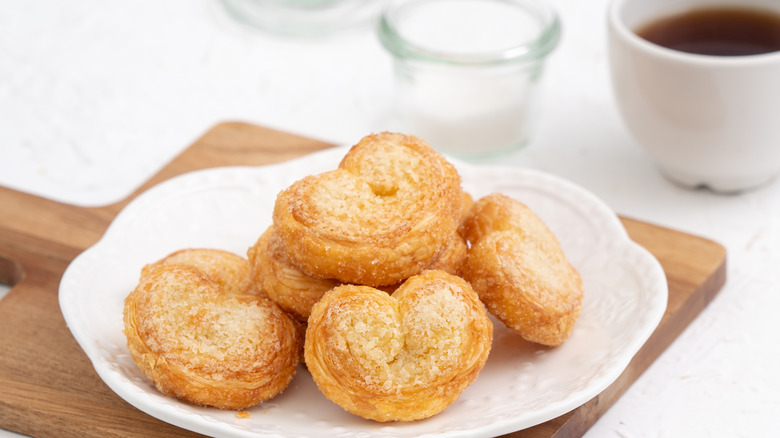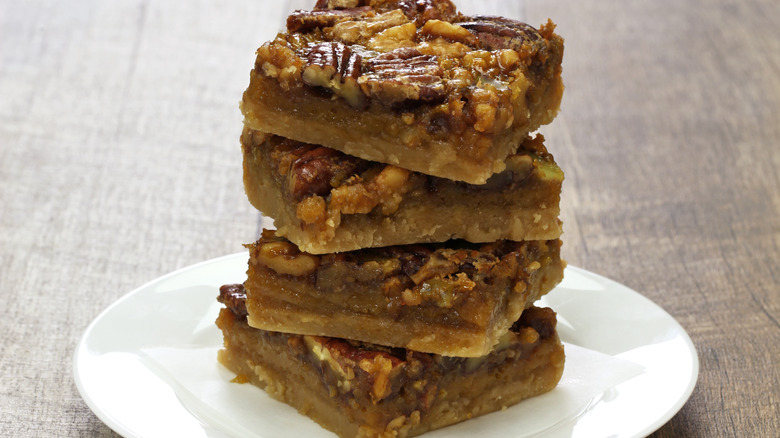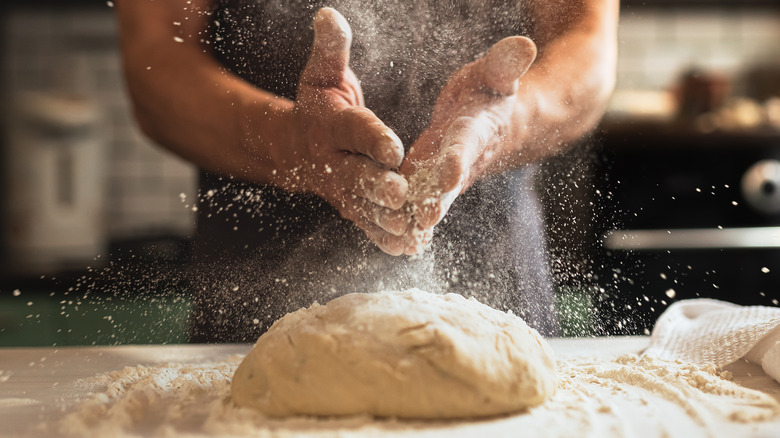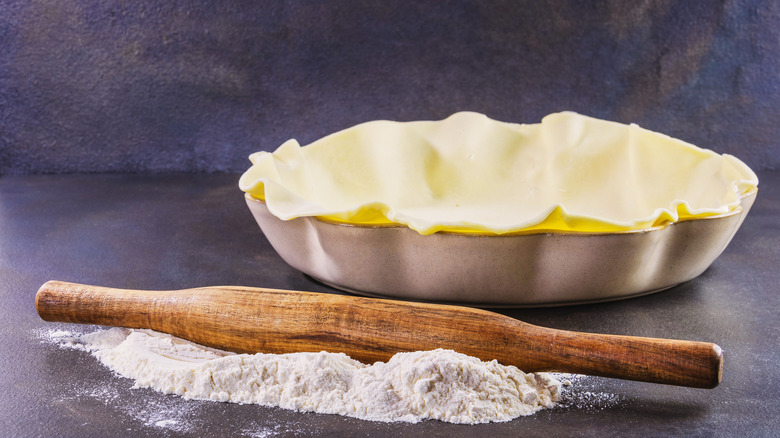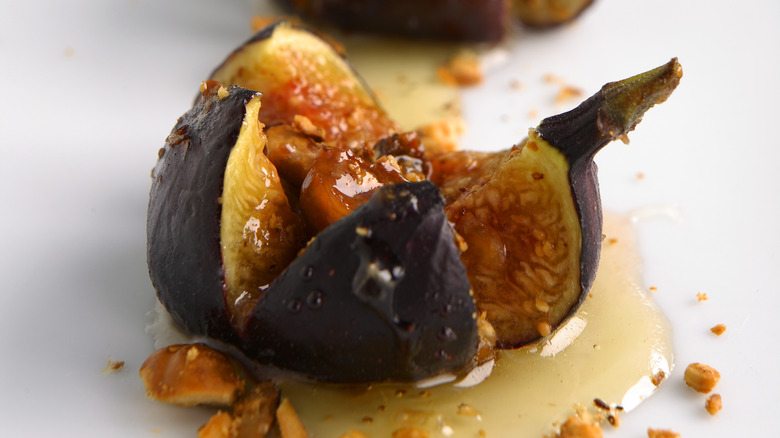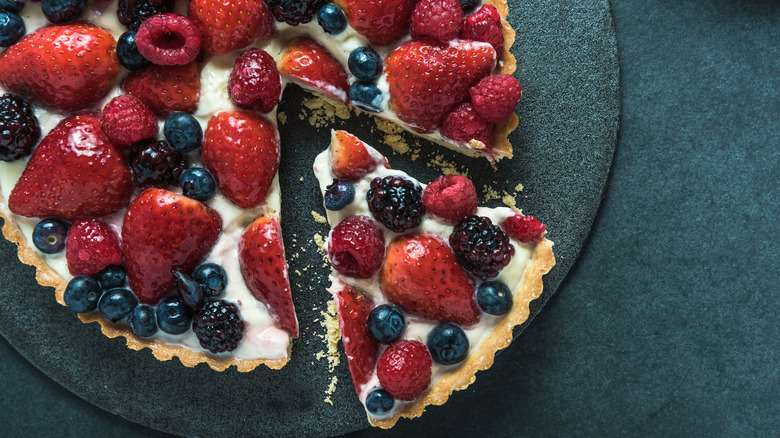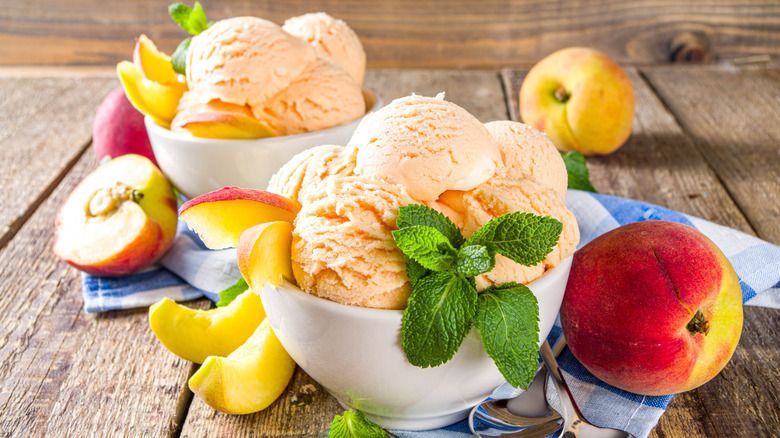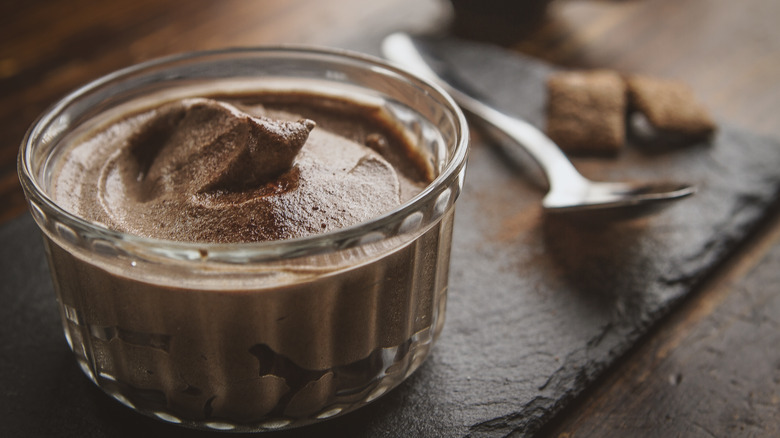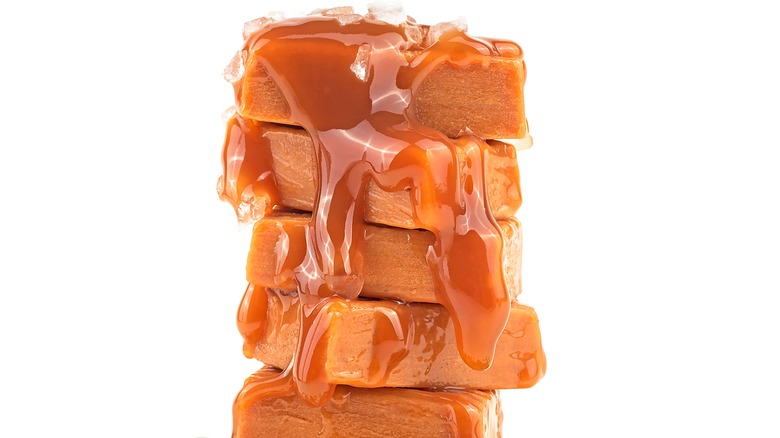14 Dessert-Making Tips From Ina Garten That You Need To Know
Ina Garten wasn't always a celebrity cooking whiz with a collection of published cookbooks and multiple TV shows on the Food Network. In the 1970s, Garten was a young working professional who threw weekend parties to unwind after long weeks of writing nuclear budget plans for the White House. Garten admits that her culinary skills weren't always sharp. As she confessed in the introduction of her cookbook, "Barefoot Contessa Parties," some of her first dinner party attempts were pretty bad. However, over time, Garten gained experience in the kitchen.
Before long, Garten was running a specialty foods store called "The Barefoot Contessa" and catering parties. By the late 1990s and early 2000s, she started publishing cookbooks and eventually sharing her knowledge on TV. These decades of diverse food-related experience have armed Garten with a plethora of helpful tips to make all kinds of home-cooked food taste professionally done, and that includes desserts. Whether it's a tip on making butter boards or the handy trick she uses to cut caramels, Ina Garten's dessert-making tips are sure to help you finish your meals with a flourish.
1. Use single-flower honey in your flavored butter
These days, flavored butter is all the rage, and with the rise of butter boards, an increasing number of home cooks are looking for a way to make their batch of creamy goodness stand out from the rest. Luckily, Ina Garten has a helpful tip to ensure that your flavored butter holds an elevated taste. As explained in her cookbook, "The Barefoot Contessa Parties," home cooks can use honey to add a boost of sweetness to their creations; however, they shouldn't use just any old honey.
According to Garten, single-flower honey is the best option for your butter, as it tends to be the highest in quality and purest in taste. The celebrity chef especially recommends mixing clover honey into your butter, probably due to its mild floral taste and warm tones of nutmeg or vanilla. Garten does, however, admit that lavender honey is also a spectacular butter sweetener. This ingredient is known for its floral amber taste and slightly crystallized texture. To put either one of these kinds of honey to good use, Garten suggests blending them into your butter along with cinnamon and a dash of Kosher salt.
2. Mix up the wines in your poached fruit
Poached pears are a French delicacy that originated in the wine regions of Lyon and Burgundy. Traditionally, this specialty involved poaching some underripe pears with local wines and plenty of spices as a way to mask the fruits' bitter flavors and bring out their inner sugars. These days, however, you can get more creative with this recipe, selecting riper, sweeter pears or even mixing up the ingredients. Ina Garten, for example, recommends experimenting with different varieties of poaching wine.
As she shared in her cookbook, "The Barefoot Contessa Parties," Garten likes to substitute the traditional French wine, Sauternes, with vin santo, an Italian alternative. In the book, Garten describes how she discovered this combination: She was actually looking for Sauternes in her pantry for vin santos, which people often consume with biscotti. The celebrity chef tried out the substitution and was thoroughly impressed.
Because of this experience, Garten tells home cooks not to just rely on her advice but to instead try their own poached fruit combinations. In her cookbook, the chef writes that vin santos can be quite expensive and that any sweet wine can work for this dish. Portuguese Port wines, for example, can taste great in poached pears. The Southern Spanish favorite, Pasas de Málaga, can also be used.
3. Prepare your miniature shortcakes in two phases
Shortcakes are a traditional British dessert that has been popular since the time of William Shakespeare. However, that doesn't mean that Ina Garten doesn't have some contemporary advice to ensure that this delightful treat is well-received at the dinner table. In her book, "The Barefoot Contessa Parties," Garten advises home cooks to prepare their miniature shortcakes in two separate phases.
First, the celebrity chef says to prepare the dough and cut it into rounds. This will allow you to do the bulk of the cooking well before your table guests arrive. Later, once everyone has finished eating the main course, Garten says to pop back into the kitchen, add a dollop of egg wash to your rounds, and throw them into the oven.
Apparently, this strategy works because it allows you to serve your shortcakes warm, enhancing both their freshness and their overall flavor. It also improves the experience of dessert by allowing the scent of your baked goods to waft over towards the dining table. Ultimately, this will get your guests in the mood for the last course, as well as encourage them to experience its flavors more fully. After all, when you consider that scent is responsible for 80 percent of a food's taste, it is only logical to try to fill your kitchen with delicious smells (via Science World).
4. Don't blend your pie crust batter
When making cookies or cakes, many home cooks are used to blending their dough all the way through. Pie crusts, however, are a totally different ball game, and Ina Garten knows it. In her cookbook, "Barefoot Contessa Parties," Garten explained that your pie crust should contain small sections of pure butter. The celebrity chef writes that it's essential to have pieces of butter in the dough, which will lead to making the pastry flaky. Indeed, this will help your final creation by allowing the butter to seep into each of your crust's different layers. On the flip side, over-handling or over-mixing your pie crust could leave you with a tough result.
Interestingly, this is far from being Garten's only advice for making the perfect pie crust. The cookbook author also recommends applying several cooling techniques to your ingredients. First, she suggests starting out by freezing your sugar and flour before working it into a dough. Later, once your dough is ready, Garten says to leave it in the fridge for half an hour before rolling. These strategies will help your butter stay cool so that it won't melt down and begin to marinate or dissolve the dough into a hard brick. Instead, these cooling techniques should help you achieve a light, flaky crust.
5. Make your meringues on a dry day
For many, rainy afternoons mean spending a few hours cooking something fun in the kitchen. That being said, Ina Garten warns that those drizzly gray days are not ideal for making meringues. Writing in her cookbook, "Barefoot In Paris," the celebrity chef explained that making meringues on a humid day might lead to them being quite sticky. Fascinatingly, there is some science behind Garten's suggestion. The sugar in your meringue can actually start to absorb the moisture in the air. As a result, you'll be left with small tears of syrup "weeping" over your meringue (via Southern Living).
To avoid this situation, try making your meringues on a hot, sunny day. Additionally, you should be careful about how you store your leftover treats. In her cookbook, Garten gave very specific instructions about where you should keep your leftover dessert: The meringues should be kept in a container at room temperature. When you are ready to enjoy them, serve your meringues with fruit salad and whipped cream.
6. Use frozen pastry dough for elephant ears
Ina Garten may have a reputation for always using the freshest ingredients, but that doesn't mean she isn't practical. When it comes to making elephant ears, Garten says it's ok to use pre-made dough in your recipe. As the celebrity chef noted in her cookbook, "Barefoot In Paris," using this unconventional ingredient can seriously speed up your cooking process. Garten wrote, that making elephant ears is quite straightforward as long as you commence by making them with pre-made puff pastry. As an added bonus, you'll be able to avoid all the sticky dough and tricky temperature issues involved with making the pastry yourself.
That being said, just because you use the pre-made dough for your elephant ears doesn't mean that making them is as simple as just throwing them into the oven. Instead, Garten suggests chilling the dough inside your fridge before putting it on the counter and getting to work. Roll out the dough until it's thin, sprinkle plenty of Kosher salt and sugar on top, then fold it into the classic elephant ear shape. The result should be a flaky sweet pastry that was quick and easy to make.
7. Bake your pecan bars with extra aluminum below them
Sometimes, the difference between a home cook and a professional chef is an eon of experience. Over the years, Ina Garten has discovered plenty of ways that sweets can go wrong, and that includes pecan bars, pecan pie, or, really, any sort of baked nut dessert. In her debut publication, "The Barefoot Contessa Cookbook," Garten warned that the sugary liquids in these types of recipes tend to boil over when they're heated. As she wrote in her recipe for pecan bars, the filling may boil and spill over the edges. Luckily, however, Garten says that you can place the foil on a lower rack for the spills.
Interestingly, Garten's pecan bar advice applies to plenty of other baked nut recipes. In her cookbook, the celebrity chef even suggests switching out pecans for other types of nuts to experiment with new flavors. In terms of her personal preferences, Garten reveals that she likes using a mixture of pecans, peanuts, and walnuts. We also highly recommend sweet almond and chia bars.
8. When baking, don't get creative with your measurements
Most recipes can stand to use a touch of creativity, but Ina Garten is here to remind us that this principle doesn't apply to baking. This is because, unlike stews or casseroles, baked goods involve specific combinations of wet and dry ingredients, which can only be used at specific temperatures. Writing in the "Barefoot Contessa Cookbook," Garten explained, "Baking ... requires exact measurements of flour, sugar, butter, and eggs, plus details like sifting the flour and having the butter at room temperature." Unfortunately, when these formulas are altered, the results can be questionable.
The good news is that Garten has some simple advice to help keep home cooks on track: follow the recipe exactly. Not only will this ensure the quality of your final product, but it will also help you develop your baking skillset. As Garten wrote in her cookbook, "The more you get into the habit of using ingredients properly, the better your baking will be." In other words, following recipes will help you build a sense of familiarity with the baking process — and maybe even allow you to use your creativity in the future.
9. Use the right baking equipment
While properly measuring your ingredients is essential to making baked goods, it's not the only thing you can do to amp up your home recipes. According to Ina Garten's cookbook, "How Easy Is That," using the right equipment can also seriously improve your baked treats. However, that doesn't mean that Garten expects home cooks to invest in the fancy stuff. The celebrity chef wrote that her top three items are a French rolling pin, a timer, and a thermometer — although, when it comes to the latter two items, she finds it helpful to have multiple of each.
Interestingly, Garten finds that each of these items helps keep her cooking on track. Garten says that she likes her French rolling pin — which resembles a whittled stick — "because I can really feel the dough when I'm rolling it out." This gives the celebrity chef more control over how thin she makes her dough. Meanwhile, her trio of timers allows her to bake multiple items simultaneously without losing track of time. Finally, Garten recommends having different types of thermometers, including oven thermometers, instant-read thermometers, and candy thermometers, to have more control over when you pull things from the oven.
10. Roast your figs to make them sweeter
When it comes to desserts, figs might be one of the most underrated ingredients. Despite their sugary, honey-filled flavor profile, many home cooks opt to leave this gorgeous magenta fruit out of their recipes. Luckily, Ina Garten has a solution to help you amp up your figs' flavor. In her cookbook, "How Easy Is That," the celebrity chef advises roasting the figs to make them even sweeter. To put this advice into action the "Barefoot Contessa" way, halve your figs and roast them directly on the baking rack for about ten minutes. According to Garten, they will grow soft when exposed to the heat of the oven.
If you have no idea how to serve baked dessert figs, fear not! Garten says to top your creation with almonds and homemade caramel sauce. Garten described the mouthwatering results and notes that the sweetness of the figs works well with the burnt taste of the caramel, and the sweet taste of the sugary caramel works well with the crunch of toasted almonds. However, people who prefer sweet and salty combinations can consider adding this curveball ingredient to a baked brie bowl or even some goat cheese pancakes.
11. Vary how much cornstarch you add to your berry tarts
Many tart recipes call for cornstarch, but Ina Garten warns that you can't always use the same amount of this ingredient. Writing in her cookbook, "How Easy Is That," the TV chef advises that the measure of cornstarch needed depends on how juicy the berries are. Interestingly enough, there is a science that backs Garten's advice. Cornstarch is a thickening agent that can transform your pie filling from a juicy mess into a concentrated, jam-like substance.
As a result, if you are going to be baking with a particularly juicy bunch of berries, you should add a bit more cornstarch to the mix. Meanwhile, pie filling made with underripe fruit will probably require a lot less cornstarch. Knowing how to apply this thickener properly can prevent you from making a soupy pie or one that's as thick as jelly. That being said, Garten says not to overly stress about your exact proportions as the result is likely to be quite delicious.
12. Add booze to your ice cream
Boozy ice creams have become something of a trend, and many people have been enjoying their desserts topped with wine. If you are looking to give your homemade ice cream a kick, Ina Garten had a creative and delicious idea. Rather than just pouring a random Cabernet into your ice cream, she suggests adding a combination of wine and fresh fruit to your creation. As the TV chef explained in her cookbook, "How Easy Is That," sweet wines can taste particularly good with ripe peaches: Garten writes that she has worked on making peach ice cream for years and found the perfect balance when combining peaches, Sauternes, and Grand Marnier.
The fruity undertones in the sweet Sauternes wine will accentuate the natural flavor of the peaches in this spectacular combination. In turn, the heavier oaky flavor of the Grand Marnier will contribute a sense of depth to the recipe, offsetting the otherwise overwhelming sweetness of the other, fruitier ingredients. For the best results, serve this dessert with a garnish of spiked peach and cherry skewers: These will add an extra punch of flavor to your recipe, as well as a little kick.
13. Watch the temperature when making chocolate mousse
Chocolate mousse can be delightful, but to make it properly, Ina Garten recommends keeping your eyes on the temperature. The explanation is that to whip up the perfect chocolate mousse, every element of the recipe must be added at the proper heat. In her cookbook, "Barefoot In Paris," Garten revealed that even the eggs in your mousse should be at a different temperature at different points in the cooking process. The celebrity chef explained that it's easier to separate cold eggs; however, it's best to whip egg whites at room temperature.
Home cooks should separate their eggs right after removing them from the fridge. Later, they can whip the whites after giving them some time to readjust their temperature. Interestingly, eggs aren't the only ingredient that needs to be prepared at a certain temperature. According to Garten, the chocolate and the butter must also be at room temperature before you whip them together. If they are too cold, they might grow into a mousse-like substance too early in the recipe. On the other hand, chocolate and butter may risk growing heavy and dense, preventing you from achieving that fluffy texture that mousse is so famous for.
14. Oil can help you cut your caramels
If you've ever tried making homemade caramels, you likely know that this recipe can prove extremely messy. You might even wonder how professional candy makers manage to shape this sticky substance into beautiful pieces. The good news is that Ina Garten has a strategy for cutting a sheet of homemade caramel into tiny little servings. In her cookbook, "How Easy Is That," the chef revealed that it's best to brush the knife with a flavorless oil such as corn oil. This will prevent your caramels from sticking to your metallic knife, allowing you to easily slice them into servings.
While Garten's trick could definitely improve the presentation of your candies, the celebrity chef admits that it won't do much to alter the flavor. As she shared in her cookbook, each time she tried making caramels, her friends ate all of them as they didn't mind if they weren't ideal. At the end of the day, Garten recommends simply enjoying your desserts. For caramels, this means eating them with a steaming hot cup of coffee.


